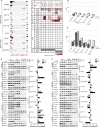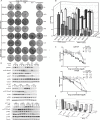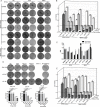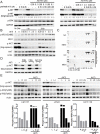Concomitant inhibition of receptor tyrosine kinases and downstream AKT synergistically inhibited growth of KRAS/BRAF mutant colorectal cancer cells
- PMID: 28002807
- PMCID: PMC5354887
- DOI: 10.18632/oncotarget.14009
Concomitant inhibition of receptor tyrosine kinases and downstream AKT synergistically inhibited growth of KRAS/BRAF mutant colorectal cancer cells
Abstract
Receptor tyrosine kinase (RTK) signaling pathways are frequently activated in cancer cells due to mutations of RTKs and/or their downstream signaling proteins such as KRAS and BRAF. About 40% colorectal cancers (CRCs) contain KRAS or BRAF mutant genes and are resistant to treatments with individual inhibitors of RTKs, AKT, MEK, or BRAF. Therefore, an understanding of the molecular mechanisms of the drug resistance is necessary for developing effective strategies to treat the diseases. Here we report the discovery of an AKT/ERK reactivation mechanism that account for the cancer cell resistance to the AKT and MEK inhibitors treatments. The reactivations of AKT and ERK after the AKT or MEK inhibitor treatment were caused by a relief of an AKT or ERK-mediated feedback inhibition of the RTKs and/or their downstream pathways. A combination of RTK inhibitors, based on the RTK activation/phosphorylation profile, synergized with the AKT inhibitor, but not the MEK inhibitor, to completely inhibit the AKT phosphorylation and to block the growth of KRAS/BRAF mutant CRC cells. These results underscored the importance of AKT and the AKT feedback signaling to cancer cell growth and offered a novel therapeutic approach for the treatment of KRAS/BRAF mutant CRC cells.
Keywords: AKT; RAS/RAF; colorectal cancer; drug combination; receptor tyrosine kinases.
Conflict of interest statement
The authors disclose no potential conflicts of interest.
Figures







Similar articles
-
Receptor tyrosine kinases exert dominant control over PI3K signaling in human KRAS mutant colorectal cancers.J Clin Invest. 2011 Nov;121(11):4311-21. doi: 10.1172/JCI57909. Epub 2011 Oct 10. J Clin Invest. 2011. PMID: 21985784 Free PMC article.
-
LY3009120, a panRAF inhibitor, has significant anti-tumor activity in BRAF and KRAS mutant preclinical models of colorectal cancer.Oncotarget. 2017 Feb 7;8(6):9251-9266. doi: 10.18632/oncotarget.14002. Oncotarget. 2017. PMID: 27999210 Free PMC article.
-
Resistance to Selumetinib (AZD6244) in colorectal cancer cell lines is mediated by p70S6K and RPS6 activation.Neoplasia. 2014 Oct 23;16(10):845-60. doi: 10.1016/j.neo.2014.08.011. eCollection 2014 Oct. Neoplasia. 2014. PMID: 25379021 Free PMC article.
-
Dual Inhibition of MEK and PI3K Pathway in KRAS and BRAF Mutated Colorectal Cancers.Int J Mol Sci. 2015 Sep 23;16(9):22976-88. doi: 10.3390/ijms160922976. Int J Mol Sci. 2015. PMID: 26404261 Free PMC article. Review.
-
KRAS, BRAF, PIK3CA, and PTEN mutations: implications for targeted therapies in metastatic colorectal cancer.Lancet Oncol. 2011 Jun;12(6):594-603. doi: 10.1016/S1470-2045(10)70209-6. Epub 2010 Dec 14. Lancet Oncol. 2011. PMID: 21163703 Review.
Cited by
-
Recent Developments in Targeting RAS Downstream Effectors for RAS-Driven Cancer Therapy.Molecules. 2021 Dec 14;26(24):7561. doi: 10.3390/molecules26247561. Molecules. 2021. PMID: 34946644 Free PMC article. Review.
-
Elucidating Ras protein as a dual therapeutic target for inflammation and cancer: a review.Discov Oncol. 2025 Jun 7;16(1):1029. doi: 10.1007/s12672-025-02783-x. Discov Oncol. 2025. PMID: 40483365 Free PMC article. Review.
-
Receptor tyrosine kinase-dependent PI3K activation is an escape mechanism to vertical suppression of the EGFR/RAS/MAPK pathway in KRAS-mutated human colorectal cancer cell lines.J Exp Clin Cancer Res. 2019 Jan 28;38(1):41. doi: 10.1186/s13046-019-1035-0. J Exp Clin Cancer Res. 2019. PMID: 30691487 Free PMC article.
-
RON and RONΔ160 promote gastric cancer cell proliferation, migration, and adaption to hypoxia via interaction with β-catenin.Aging (Albany NY). 2019 May 13;11(9):2735-2748. doi: 10.18632/aging.101945. Aging (Albany NY). 2019. PMID: 31085796 Free PMC article.
-
Capturing dynamic relevance in Boolean networks using graph theoretical measures.Bioinformatics. 2021 Oct 25;37(20):3530-3537. doi: 10.1093/bioinformatics/btab277. Bioinformatics. 2021. PMID: 33983406 Free PMC article.
References
MeSH terms
Substances
LinkOut - more resources
Full Text Sources
Other Literature Sources
Medical
Molecular Biology Databases
Research Materials
Miscellaneous

